
|
Vol 69 |
Page 19 |
Privacy Policy | Editorial Policy | Profit Policy | Join the Association | List of Members | Contact us | Index | Links
Back Go to page: 1 2 3 4 5 6 7 8 9 10 11 12 13 14 15 16 17 18 19 20 Forward
While the Association does not necessarily agree or disagree with everything on this page,
we do respect the right of everyone to have their say.
Your say!
Contents:
Chinese Scientists warn of Global Cooling.
Climate Change off the burner.
RAAF Apprentice Scheme investigation.
Wallaby Airlines to the rescue.
If you’re one of the unlucky ones who were stung when they commuted part of their DFRDB on discharge, there might just be some light at the end of the tunnel. There has been a major review of the DFRDB system which was done by the Ombudsman and which is 83 pages long – you can see it HERE. As a result of this, there is now a claim form which you can fill out which just might give you some comfort.
Click HERE, download the form which is in Word format, fill it in on line and send it off to the Directorate of Special Financial Claims in Canberra (the address is on the form).
Fingers crossed!
The secret Defence probe into alleged unlawful killings by Australian special forces in Afghanistan enters final stages
A secret inquiry into alleged war crimes by Australian special forces is in its final stages and is focussing on accusations of unlawful killings and the cruel treatment of civilians and former enemy fighters. The secret inquiry has been running since May 2016 and members of the Defence community are annoyed at how long the investigation is taking. The Inspector General of the Australian Defence Force says the probe is in its final stages. Investigators are looking into 55 separate incidents of alleged breaches of the rules of war in Afghanistan between 2005 and 2016.
A total of 336 people have given evidence to the probe so far.
The inquiry, by the Inspector General of the Australian Defence Force (IGADF), has been underway since May 2016 and was sparked by allegations and rumours of special forces troops killing unarmed Afghan men and children.
The latest update was contained in the organisation's annual report for 2018-2019, which was only tabled in the Senate recently despite being signed by Inspector General James Gaynor in November last year. It said the investigation was aimed predominately at "unlawful killings of persons who were non-combatants or were no longer combatants, but also 'cruel treatment' of such persons."
The Inquiry is not focused on decisions made during the 'heat of battle', rather, its focus is the treatment of persons who were clearly non-combatants or who were no longer combatants.
The secretive probe is being led by former New South Wales Supreme Court Justice Paul Brereton, who travelled to Afghanistan last year to interview witnesses along with Australian Federal Police officers. The starting point for the IGADF Afghanistan Inquiry — vague rumours of Special Forces soldiers' very serious wrongdoing over a period of more than 10 years — was much less well-defined. Defence Minister Linda Reynolds said she expected the inquiry's final report to be delivered in the next few months. "The ADF is well known and highly respected around the world for its exemplary standards and its insistence on them," she said. "Where there are serious rumours and allegations raised about the conduct of our ADF members, Australians would rightly expect that they are thoroughly examined according to the rigorous and well-established processes in place. "Australians would also expect that ADF members are treated with utmost fairness throughout these processes."
Peter Condon, who flew bird dogs in Vietnam, is against this probe, he recently wrote a letter to the editor of his local newspaper, it’s republished here:
“The Inspector-General of the Australian Defence Force (IGADF) is conducting an Inquiry into rumours of possible breaches of the Laws of Armed Conflict by members of the Australian Defence Force (ADF) in Afghanistan, between 2005 and 2016.
To do this inquiry, the IGADF has placed notices in local Afghani newspapers seeking evidence of possible breaches of the laws of armed conflict by Australian servicemen while on operations in a war zone. What an incredible ask. What kind of un-Australian legal professional suggested this approach. Basically, they are asking the enemy to list their complaints into Aussie behaviour while on patrols—no doubt the Afghanis are expecting some monetary compensation. I find the IGADF approach positively appalling.
Being a retired serviceman who served as a Forward Air Controller in Vietnam, where I heard of Viet Cong atrocities against local village leaders and others, I know that usual standards deteriorate when on the battlefield. One cannot suppress the emotion of hate for an enemy combatant when one sees the enemy soldier cut a mate’s throat. Do you kill that enemy soldier or take him as a prisoner during the hectic battle in progress? If arresting him may cause you to be killed, you kill him. All readers will have experienced the hate that I’m trying to describe when they viewed videos of recent Islamic State atrocities such as the cutting off of a defenceless prisoner’s head with a knife and the burning alive of captives in a cage—and that was not while under extreme pressure on the battlefield. The current enemies who we are fighting have no rules.
Changes were made to the Military Justice System in 1985 where the purpose of the Defence Force Discipline Act (DFDA) is to maintain and enforce military discipline. It applies to all Australian Defence Force members in times of peace and war and includes offences that are uniquely military and other offences that occur in a military environment. However, having legal professionals, or anybody else without battlefield experience making decisions on a soldier’s behaviour on the battlefield is just not appropriate. They don’t understand the complex emotions involved in battle. I often heard the fear in the voices of the infantrymen under attack when they asked me for help. Prior to 1985, Commanding Officers in a combat zone heard charges against their subordinates, and understanding the environment in which the offence occurred, made a decision to punish the offender or not. More serious charges were heard by a Courts Martial panel comprised of senior war experienced officers. The decision was not handed to higher headquarters in Australia years later where the legal teams have no clues other than what is written in a book of law. Peacetime experiences cannot be compared.
Some time ago I researched Charles Bean’s writing on the Gallipoli landing in 1915 and I thought I should include a couple of quotes here for the members of the IGADF team. When the Aussie soldiers were rushing up the side of Ari Burnu Knoll only minutes after landing in their small boats, an Australian soldier captured a Turk soldier with his bayonet because his rifle was still full of sand. “Prisoner here” he shouted. “Shoot the bastard” was all he heard from his mates scrambling up the hill. The men had been constantly warned that Turks mutilated men whom they captured or found wounded; but in this case the Turk soldier was escorted down to the beach. War is a dirty business.
Soon after the Turk was spared, some Turks who had caused havoc on one of the landing boats at close range below the Knoll ran from their trench hoping to escape along Shrapnel Gully, but they were chased and caught. “As the Australians got among them, the Turks threw down their rifles; but they were too many to capture, and they were consequently shot.” These two incidents happened in the first 60 minutes after landing so any reader should get an appreciation of what probably went on for the remainder of the first day—let alone the whole war. Hate in war is normal. In fact, if you want to win the war, hate is expected.
The Afghanistan Inquiry called by the Inspector General of the Australian Defence Force is a most un-Australian move. May I suggest that the Australian Government steps in and stops this extraordinary hearing. To me it is downright disgusting for the Australian Defence Force to be investigating battlefield actions of our soldiers years after the events supposedly took place. Are they going to go back and examine all of the WWI, WWII, Korea and Vietnam actions too? Yes, there were more. Remember, besides hate on the battlefield there is plenty of fear there too; combine the two and you get some pretty unpredictable soldiers. Unfortunately, the inquiry lawyers would not have experienced those battlefield emotions. Let’s hope the judges have front line experience, or at least can suggest to the government that the inquiry be abandoned because their task involves more than the written law; and they are not qualified to judge.
A shameful episode in the governance of the Australian Defence Force”.
DVA Review of TPI Benefits report.
The Department of Veterans’ Affairs (DVA) commissioned KPMG to examine the TPI Federation’s campaign for an increase in the TPI payment. KPMG analysed the arguments put forward by the TPI Federation in support of their campaign against the legislative and policy basis for the current TPI payment rate. The same analysis was also conducted on an alternative payment structure proposed by the Disabled Veterans of Australia Network. This included investigation of the overall levels of support available for TPI veterans and consideration of whether any cohorts of the TPI population need greater assistance than others.
KPMG also compared the draft recommendations of the Productivity Commission review “A Better Way to Support Veterans”, released on 11 December 2018, against the TPI Federation’s response to the draft Productivity Commission report and their proposed alternative recommendations.
The KPMG Review of TPI Benefits was completed and provided to DVA on 15 November 2019. You can get a copy HERE.
If the Corona Virus has done anything, it has got Climate Change off the ABC and out of our lounge rooms and has also give us a break from that spoilt, rather obnoxious brat of a kid, Greta Thunberg. The world’s climate is changing, blind Freddy can see that, what we have trouble with is accepting that humanity is the main reason for that change.
THIS is worth looking at and so is THIS.
Charley, an elderly but new employee at Bunnings, just couldn't seem to get to work on time. Every day he was 5, 10, 15 minutes late. But he was a good worker, really tidy, clean-shaven, sharp-minded and a real credit to the company and obviously demonstrating their "Older Person Friendly" policies. One day the boss called him into the office for a talk. "Charley, I have to tell you, I like your work ethic, you do a bang-up job when you finally get here; but your being late so often is quite bothersome." "Yes, I know boss, and I am working on it." "Well good, you are a team player. That's what I like to hear. Yes sir, I understand your concern and I'll try harder. Seeming puzzled, the manager went on to comment, It's odd though, your coming in late. I know you're retired from the Armed Forces. What did they say to you there if you showed up in the morning so late and so often?" The old man looked down at the floor, then smiled. He chuckled quietly, then said with a grin, "They usually saluted and said, Good morning, Air Commodore, can I get your coffee, sir?”
Chinese Scientists warn of imminent Global Cooling.
Climate change is real, the climate changes — this fact is never disputed. A new study, led by prominent Chinese scientists, has found that winters in northern China have been warming for the past 6,000 years –unrelated to human activity– but now the prospect of a sudden and severe bout of global cooling is on the horizon and poses a serious danger.
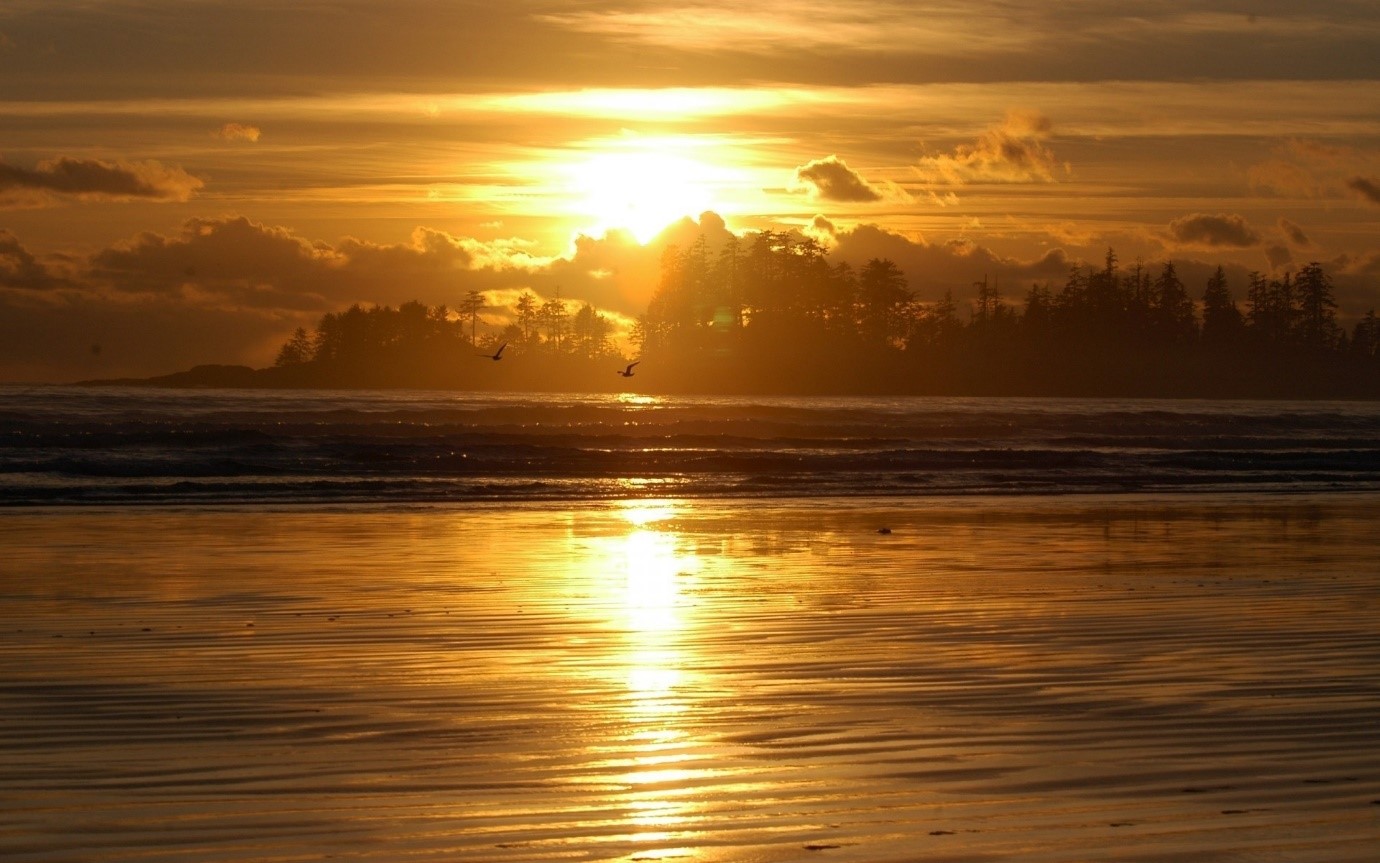
The paper, which has been accepted for publication by the online Journal of Geophysical Research, found that winds from Arctic Siberia have been growing weaker for thousands of years, the conifer tree line has been retreating north and there has been a steady rise in biodiversity in a general warming trend that continues today. And that’s another thing AGW alarmists fail to address, increasing temperatures ALWAYS result in increased biodiversity. Life loves warmth, and, furthermore, it loves carbon.
This weakening of the Siberian wind, according to the researchers, appears to have nothing to do with the increase in greenhouse gases which began with the industrial revolution. Lead scientist Dr Wu Jing, from the Chinese Academy of Sciences, said the study had found no evidence of human influence on northern China’s warming winters.
“Driving forces include the sun, the atmosphere, and its interaction with the ocean,” Wu explained. “We have detected no evidence of human influence, but that doesn’t mean we can just relax and do nothing.”
Wu and her colleagues are worried that, as societies become further indoctrinated by the concept of global warming, people will develop a misplaced confidence in our ability to control the climate, which we cannot. Nature, they warned, will likely trick us and catch us totally unprepared, potentially causing chaos, panic, famine and even wars.
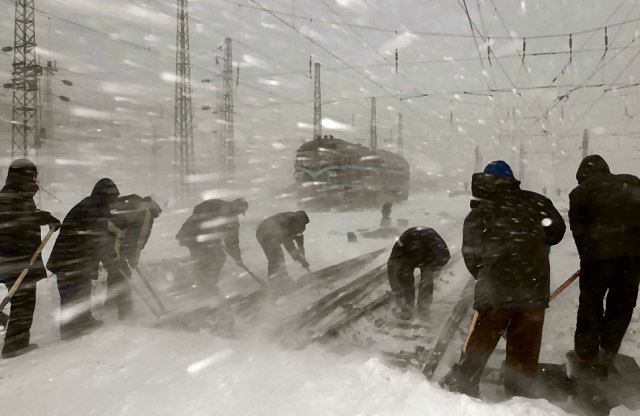
Rail-workers braving the cold in central China in 2008 (during solar minimum of weak solar cycle 24), when the nation was hit by devastating winter storms.
There are already concerning signs, according to their paper.
Wu and her colleagues have found that winter warming over the past 6,000 years has been anything but linear, with violent ups and downs occurring roughly every 500 years. After more than 13 years of dedicated research across volcanic lakes in the wilderness of the Greater Khingan Mountain Range in Inner Mongolia, the scientists collected and crunched climate data spanning as far back as 10,000 years and their findings confirmed an earlier study by a separate team of Chinese scientists, published in 2014, which first detected the 500-year cyclical pattern of China’s summer monsoons and linked it to solar activity.
The 2014 paper, which drew on 5,000 years’ worth of proxy data, suggested the current warm phase would end within the next several decades, ushering in a brutal 250-year cooling phase. Wu said her latest study not only helped to flesh-out the 500-year cycle, but also revealed a previously unknown mechanism behind the phenomenon, which suggested the impact of the sun on the Earth’s climate is much greater than previously thought.
According to Wu, the variation in solar activity alone was not normally strong enough to induce the rapid changes in vegetation the research team observed within the sediment cores of the volcanic lakes. Instead, the scientists found the warming impact was amplified by a massive interaction between surface seawater and the atmosphere in the Pacific Ocean known as the ‘El Nino-Southern Oscillation’. As a result of the research findings, Wu said she was now much more worried about global cooling than global warming. “A sharp drop in temperature will benefit nobody,” she said. “The biggest problem is that we know it will come, but we don’t know exactly when.”
The cold times are returning in line with historically low solar activity, and a growing number of scientists from all corners of the world are coming out with this warning. Even NASA agrees, in part at least, with their SC25 forecast revealing it will be “the weakest [solar cycle] of the past 200 years”, with the agency correlating previous solar shutdowns to prolonged periods of global cooling – see HERE.
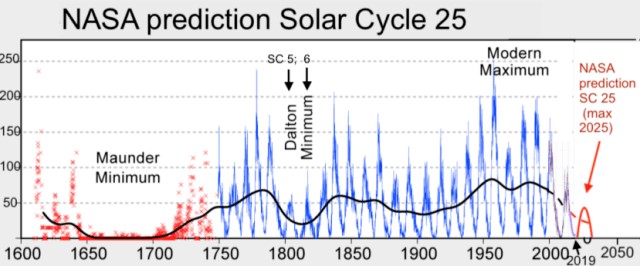
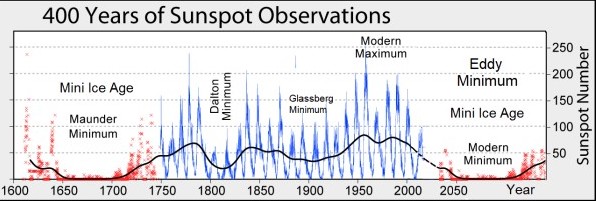
People need to prepare for the cold, but unfortunately the message stuck on loop across the MSM is one of impending catastrophic warmth, which is illogical and misguided, at best and unfortunately we don’t have long.
PS. Antarctica just set its coldest March temperature on record, minus 75.30C – see HERE
It was a quiet Monday morning in September 2053 when John awoke with a need to go to the toilet.
To John this wasn’t just an ordinary day, this was the day he would open the last package of toilet paper his parents had bought in the year 2020.
Scientists attribute the global warming trend observed since the mid-20th century to the human expansion of the "greenhouse effect", warming that results when the atmosphere traps heat radiating from Earth toward space.
Certain gases in the atmosphere block heat from escaping. Long-lived gases that remain semi-permanently in the atmosphere and do not respond physically or chemically to changes in temperature are described as "forcing" climate change. Gases, such as water vapor, which respond physically or chemically to changes in temperature are seen as "feedbacks."
Gases that contribute to the greenhouse effect include:
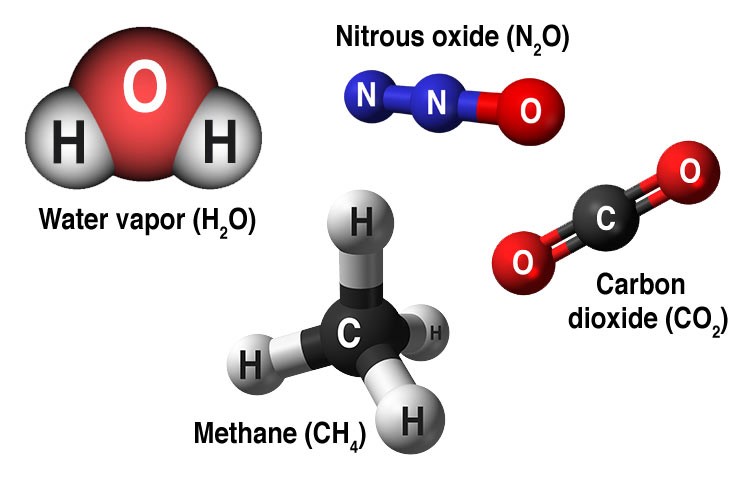
Water vapour. The most abundant greenhouse gas, but importantly, it acts as a feedback to the climate. Water vapor increases as the Earth's atmosphere warms, but so does the possibility of clouds and precipitation, making these some of the most important feedback mechanisms to the greenhouse effect.
Carbon dioxide (CO2). A minor but very important component of the atmosphere, carbon dioxide is released through natural processes such as respiration and volcano eruptions and through human activities such as deforestation, land use changes, and burning fossil fuels. Humans have increased atmospheric CO2 concentration by more than a third since the Industrial Revolution began. This is the most important long-lived "forcing" of climate change.
Methane. A hydrocarbon gas produced both through natural sources and human activities, including the decomposition of wastes in landfills, agriculture, and especially rice cultivation, as well as ruminant digestion and manure management associated with domestic livestock. On a molecule-for-molecule basis, methane is a far more active greenhouse gas than carbon dioxide, but also one which is much less abundant in the atmosphere.
Nitrous oxide. A powerful greenhouse gas produced by soil cultivation practices, especially the use of commercial and organic fertilizers, fossil fuel combustion, nitric acid production, and biomass burning.
Chlorofluorocarbons (CFCs). Synthetic compounds entirely of industrial origin used in a number of applications, but now largely regulated in production and release to the atmosphere by international agreement for their ability to contribute to destruction of the ozone layer. They are also greenhouse gases.
Not enough greenhouse effect:

The planet Mars has a very thin atmosphere, nearly all carbon dioxide. Because of the low atmospheric pressure, and with little to no methane or water vapor to reinforce the weak greenhouse effect, Mars has a largely frozen surface that shows no evidence of life.
Too much greenhouse effect:
The atmosphere of Venus, like Mars, is nearly all carbon dioxide, but Venus has about 154,000 times as much carbon dioxide in its atmosphere as Earth (and about 19,000 times as much as Mars does), producing a runaway greenhouse effect and a surface temperature hot enough to melt lead.
On Earth, human activities are changing the natural greenhouse. Over the last century the burning of fossil fuels like coal and oil has increased the concentration of atmospheric carbon dioxide (CO2). This happens because the coal or oil burning process combines carbon with oxygen in the air to make CO2. To a lesser extent, the clearing of land for agriculture, industry, and other human activities has increased concentrations of greenhouse gases.
The consequences of changing the natural atmospheric greenhouse are difficult to predict, but certain effects seem likely:
-
On average, Earth will become warmer. Some regions may welcome warmer temperatures, but others may not.
-
Warmer conditions will probably lead to more evaporation and precipitation overall, but individual regions will vary, some becoming wetter and others drier.
-
A stronger greenhouse effect will warm the oceans and partially melt glaciers and other ice, increasing sea level.
-
Ocean water also will expand if it warms, contributing further to sea level rise.
Meanwhile, some crops and other plants may respond favourably to increased atmospheric CO2, growing more vigorously and using water more efficiently. At the same time, higher temperatures and shifting climate patterns may change the areas where crops grow best and affect the makeup of natural plant communities.
The Role of Human Activity
In its Fifth Assessment Report, the Intergovernmental Panel on Climate Change, a group of 1,300 independent scientific experts from countries all over the world under the auspices of the United Nations, concluded there's a more than 95 percent probability that human activities over the past 50 years have warmed our planet. The industrial activities that our modern civilization depends upon have raised atmospheric carbon dioxide levels from 280 parts per million to 412 parts per million in the last 150 years. The panel also concluded there's a better than 95 percent probability that human-produced greenhouse gases such as carbon dioxide, methane and nitrous oxide have caused much of the observed increase in Earth's temperatures over the past 50 years.

The panel's full Summary for Policymakers report is online HERE.
Solar Irradiance.
The graph below compares global surface temperature changes (red line) and the Sun's energy that Earth receives (yellow line) in watts (units of energy) per square meter since 1880. The lighter/thinner lines show the yearly levels while the heavier/thicker lines show the 11-year average trends. Eleven-year averages are used to reduce the year-to-year natural noise in the data, making the underlying trends more obvious.
The amount of solar energy that Earth receives has followed the Sun’s natural 11-year cycle of small ups and downs with no net increase since the 1950s. Over the same period, global temperature has risen markedly. It is therefore extremely unlikely that the Sun has caused the observed global temperature warming trend over the past half-century.
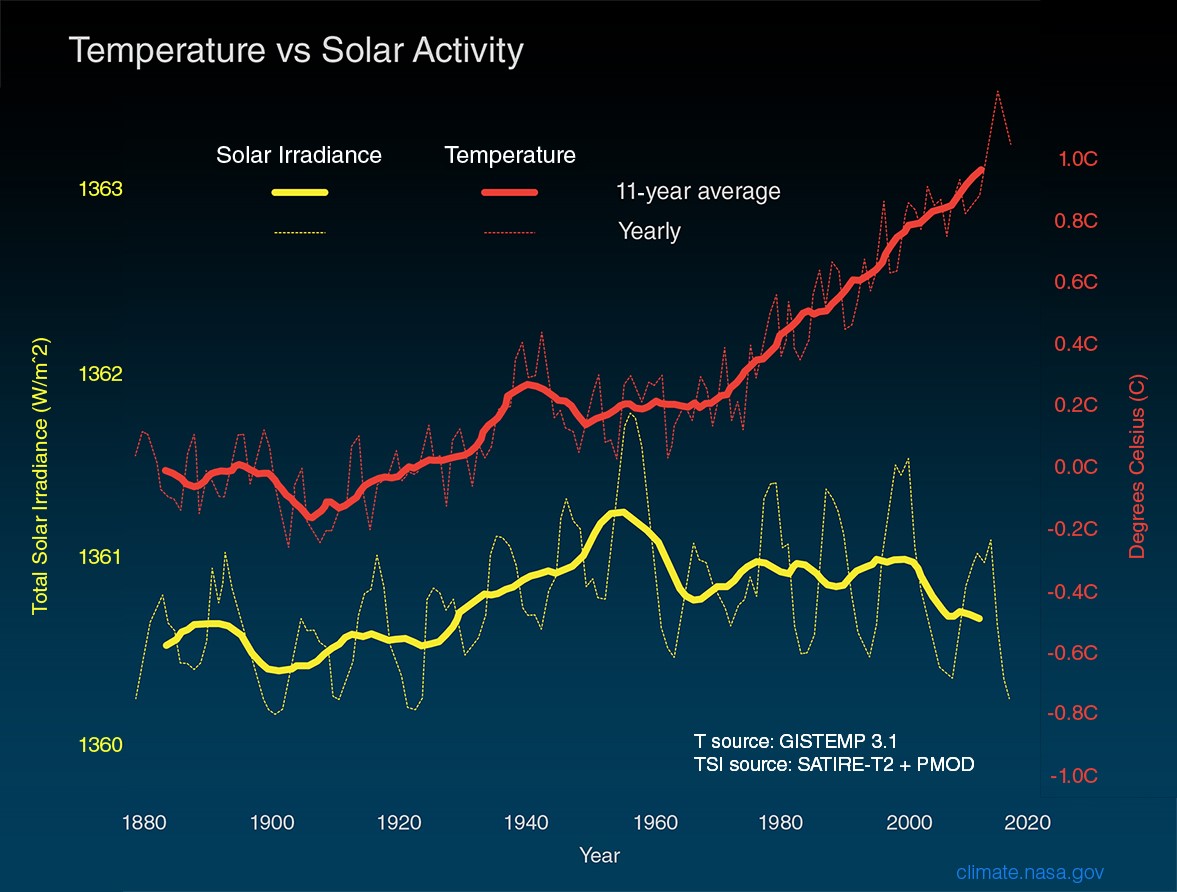
It's reasonable to assume that changes in the Sun's energy output would cause the climate to change, since the Sun is the fundamental source of energy that drives our climate system. Indeed, studies show that solar variability has played a role in past climate changes. For example, a decrease in solar activity coupled with an increase in volcanic activity is thought to have helped trigger the Little Ice Age between approximately 1650 and 1850, when Greenland cooled from 1410 to the 1720s and glaciers advanced in the Alps.
But several lines of evidence show that current global warming cannot be explained by changes in energy from the Sun:
Since 1750, the average amount of energy coming from the Sun either remained constant or increased slightly. If the warming were caused by a more active Sun, then scientists would expect to see warmer temperatures in all layers of the atmosphere. Instead, they have observed a cooling in the upper atmosphere and a warming at the surface and in the lower parts of the atmosphere. That's because greenhouse gases are trapping heat in the lower atmosphere.
Climate models that include solar irradiance changes can’t reproduce the observed temperature trend over the past century or more without including a rise in greenhouse gases.
SO! Believe what you must – tb!
Subject: RE: Climate change.
Ray Payne OAM
Veteranweb Network
I am writing this because I am appalled at the amount of near-hysterical reaction to the recent NSW and Qld bush-fires. My reasoning is not so much about the fires or the people affected, but about whether "man-made" climate change is the underlying cause. Before I go further, my stance is not so much a personal but rather a professional reaction.

I begin by telling those of you who don't know, for a period of some 40 years, my work as a loss adjuster was involved with natural disasters, ranging from Cyclone Tracey through to a lesser involvement in 2009. I was appointed as National Chief Loss Adjuster, an advisory role, to the Insurance Council of Australia on all-natural disasters but particularly bush-fires. This role was interactive with all agencies and spanned more than 10 years. It was both proactive in planning stages and reactive after the event. I was heavily involved in the 1983 Victorian fires.
I acknowledge the advice of The Bureau of Meteorology and the Climate Council, is a reality to the effect the projected changes to climate, was derived from modelling, which strongly suggested change would occur unless man-made contribution was reduced.
Somehow or other, sections of our communities, have taken control of the scientific argument about the future and have interpreted it to mean the change has already occurred. Not so. Records I have seen, actually show that the slight upward trend in temperatures on a global scale seems to be in direct line with the earth's ever occurring "natural" climatic change patterns. History shows numerous ice ages, when the planet cooled, to corresponding heating up periods, over billions of years. This has always occurred. It is the nature of our planet and cannot be influenced by what man can or cannot do. On the other hand, the impact of humans is a future projection, well-founded on scientific modelling.
The true position, despite all the comments about what the current fires mean in a climate change scenario, is nobody can tell if there is any connection.
What I can tell you with absolute certainty is that these fires, as bad as they were, are no more intense, widespread, dangerous or unexpected in outcome, to many previous and historic events. There is no accurate method to measure such outcomes, however, it is possible to look at prevailing conditions and contributing factors to seek patterns or influential factors.
Take a look at the following comparative data, much of which has been ignored by the frantic argument to directly link man-made climate change to the outbreak and effects of these latest fires. I detail some of the arguments I have heard go unchallenged or are simply ignored and unreported, particularly by the ABC who are the appointed official national disaster communications service.
This the first time such fires have been rated as catastrophic. True, but not because they were rated any worse than many previous fires. In 2009, following the bush-fire inquiry, the defined categories of fire were renamed. Catastrophic was introduced as the most severe warning, so this description was never intended to make people think they were the worst fires ever. I have heard many media reports entrench this mistake.
The fires are occurring earlier because of climate extending the summer risk. This can only be applicable in the North, however NSW has a long history of November and December bush-fires. In 1944, the Blue Mountains lost 27 homes and other property in November. Since then, I can recall at least 3 other similarly timed events in NSW, so this year was not unique, as has been strongly inferred by many reporters. In southern areas, January and February have historically been prone to outbreaks.
These fires are the most widespread and worst ever.
They certainly were disastrous, however, it is impossible to compare them unless it can be based on raw data…. Have more lives been lost than ever before. No, although 1 is far too many, in 2009, 173 people died. In 1983, 75 people died. In 1962, 62 people died. In that decade one of the victims in Eltham North was George Crowe, my Grandfather and Grandma's father in law. In 1967, it was reported that 2,600 square kms of land was devastated in just 5 hours (Just try to imagine that ferocity). In 2009 there were 2030 homes destroyed and in 1983 there were 6,000 homes and other buildings destroyed. Does this define which fire was the worst? NO. All fires are bad but to try and claim the current fires are the worst ever is a blatant disregard for historical fact. Worse still, it is a deliberate attempt to scare people into accepting the fanatical side of the global warming argument, by accepting radical changes to our economy, power generation and mining {let alone agriculture and transport} must occur right now and in a premature manner. The so-called re-definition of the predicted changes into an emergency is a way to virtually destroy our entire way of life.
The fires were started as a result of climate changed conditions. Clearly wrong. 80% of fires were started by people either deliberately or accidentally lighting them. Dry lightning strikes have been long recorded and are nothing new.
What has our Media and ABC generally ignored? One of the clearest data-based facts, reported out of the 2009 Inquiry, was the finding that fire intensity is proportional to and severely aggravated by fire loads created by undergrowth and forest floor debris accumulation. We can't control wind and heat but we can control fuel load. Ask any active Rural or Country serving fireman what they think of this hazard. Then ask your Green Party representative, why they have influenced the management of National Park maintenance, as well as local government reserves, to leave far too much of the forest floor intact at any cost. Winter back burning, firewood removal and general debris clearance have been widely restricted by stupid laws. They argue it preserves natural ecosystems that rely on such decaying material. Well, systematic removal of this fuel load may well disrupt some Eco-systems, consider this; a bush-fire positively destroys them all.
The only identifiable and the recently introduced risk factor is the environmental law changes that have impacted a fire's intensity potential and capacity to burn faster and hotter.
Find this hard to believe, go into a forest and try setting fire to a living gum tree with a match. Now stoop down and see if you get any better results from the dead and therefore dry undergrowth at your feet. This is the effect ember spread has on adjoining bush-land.
There is much more to say about bringing sanity back into discussions and I have my own opinion that if you believe the science of global warming, stick to the science and ignore the fanatical self-professed experts, like some of the current crop of Green Party politicians and shrieking media, self-appointed, experts. No, before it can be said, I was not self-appointed in my former career positions.
I can only reflect that the handful of ex-firemen who were paraded before the media, may have had other agendas. The spokesman listed his current occupation as a "Climate Change Consultant". Another said outright, on camera, that fires have always been linked to climate change. I prefer to listen to our Indigenous community who talk of bush-fire management over thousands of years. - oops before any hint of an industrial age, meat production or mining.
(The Veteranweb Network providing information to Australian veterans, ex-service, and service personnel. Reaching more than 12,980 readers daily and growing.
All service and ex-service personnel can subscribe to the Veteranweb Network cost-free, simply provide your service number and unit. Information is provided via email from various reliable sources. Veteranweb is an information service, while it is not a forum you are welcome to contribute.)
Dr Oz says rubbing coffee grounds on your naked body prevents cellulite. Apparently you can't do it in Starbucks.
And now the cops are here.
No comment necessary - tb!

The following letter was sent to Graham Trezise who was on 17 Appy. It was sent by Kerry Stewart of law firm, Norton Rose Fulbright.
Dear Sir,
We are solicitors retained by the Department of Defence to provide advice in relation to a number of claims which have been brought by former apprentices who attended the RAAF base, Laverton. We have identified you as a potential witness from documents provided to us by the Department of Defence.
The purpose of this letter is to seek your assistance to understand the history of apprentice training at RAAF Laverton and RAAF Wagga. We are very interested to speak with former members of the RAAF who were posted to Laverton during the 1970s and 1980s. We would appreciate the opportunity of speaking with you to obtain any information you may be able to provide in relation to how this particular base was operated, the day to day operation of the Apprentice Squadron and to gain a greater understanding of the life of apprentices within the Apprentice Squadron.
We wish to confirm that there are no allegations which have been made against you.
If you are able to assist we would appreciate it if you would contact Kerry Stewart on 02 9330 8885 or by email on kerry.stewart@nortonrosefulbright.com. If, however you were not a member of the RAAF and posted at Laverton we would appreciate it if you would let us know that we have contacted the incorrect person sharing your name.
We would appreciate hearing from you, if possible, within the next 14 days.
Should you wish to consult with Defence direct prior to responding to us, please feel free to contact Mr Michael Lysewycz, the Defence Special Counsel, on 02 6266 2004

Kerry Stewart Special Counsel
Norton Rose Fulbright
Australia Partner: Rebecca Whittle

Wallaby Airlines hops in to help evacuate endangered wildlife from ACT fires and hot weather.
Fires? What fires? Not long ago Australia was in the grip of some devastating bush fires, they were what everyone was talking about, everyone knew someone who was affected or had been to a town or a place that no longer exists, people were rallying around helping where they could, donations were collected, TV ran endless stories showing some poor person’s burnt out home, it was said it was the worst calamity to ever hit our shores.
But today, nothing!!
Today, hardly a mention, all those poor people who lost everything have been swept onto the back burner as we grapple with yet another disaster. Living in Australia is like that.
During those terrible times, the more vocal but ignorant radio announcers were screaming that the ADF should be brought in to put out the fires, after all, fighting bush fires was a month long subject taught at Laverton and Wagga, right? Sending a bunch of techs out to fight bush fires would be catastrophic in itself, when we were at Richmond in the late 60's we can remember been sent to the Blue Mountains to help fight a fire, it was a complete waste of time, no-one had any idea what to do or how to do it, we stumbled around with a long pole which had a piece of bag at the end of it and made complete nuisances of ourselves. No, leave the fire fighting to the fire fighters.
But, behind the scenes, the ADF did help and 35Sqn at Amberley did a lot.
The following article appeared on the ABC’s site
“With a heatwave and high winds forecast, the call was made to evacuate the Tidbinbilla Nature Reserve, near Canberra.
Key points:
-
Endangered brush-tailed rock wallabies and eastern bettongs were evacuated from Canberra during bushfire
-
Defence aircraft carried the animals to Geelong, Melbourne, and Sydney for safety and treatment
-
The RAAF's No 35 Squadron, named Wallaby Airlines in Vietnam, carried actual wallabies in a first for crew
It was a last resort decision, made necessary by the Orroral Valley bushfire that continued to burn in Namadgi National Park.
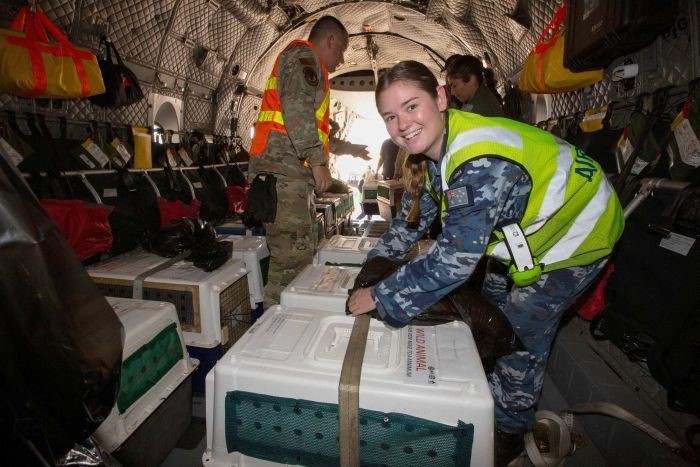
Emma Nearmy from Air Movements assists with the loading
of 17 wallabies onto one of 35 Sqn’s Spartans in Feb 2020.
"We had this threshold of when it got to a place called Corin Dam, regardless of where it went from there, we decided we'd evacuate the animals," said Peter Cotsell, director of the Namadgi National Park, Tidbinbilla Nature Reserve, and the Murrumbidgee River Corridor.
"It was a good time to evacuate and I believe we did the right thing."
Moving the evacuees, critically endangered brush-tailed rock wallabies and eastern bettongs across state lines during a bushfire crisis was not going to be easy. You can see video of them being released HERE
It was not just a matter of booking an aircraft large enough to carry so many animals; like any flight, it was important to keep the 'passengers' calm. "You're facing the challenges of them getting really stressed and just dying from stress," biodiversity director Annette Rypalski from the Mt Rothwell Biodiversity Interpretation Centre said. "We had to make sure we kept them as calm as possible."
She estimated there were fewer than 150 brush-tailed rock wallabies left.
Mt Rothwell conservation and Research Reserve at Little River, near Geelong, was chosen as the home away from home for the evacuees because of its fire safety, good infrastructure, and the staff's animal-handling skills. Wallabies needing medical treatment were sent to Taronga Zoo in Sydney while four others were sent to Healesville Sanctuary, near Melbourne. Mt Rothwell, a 453-hectare reserve, already home to a colony of southern brush-tailed wallabies, is surrounded by fencing to keep foxes and cats out.
The wallabies had been housed in smaller yards while
the bushfire threat was imminent, so the team at Tidbinbilla Nature
Reserve could move quickly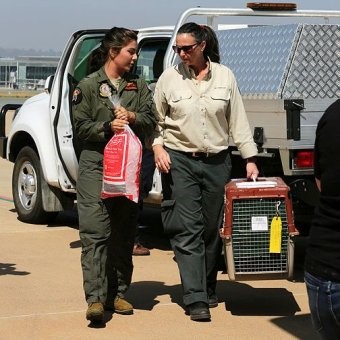 when the need arose, but there was still the matter of how to fly the
animals under incredible time constraints. This fire roared over this
mountain top and grew quite quickly, so they had to act really fast
when the need arose, but there was still the matter of how to fly the
animals under incredible time constraints. This fire roared over this
mountain top and grew quite quickly, so they had to act really fast
Antonia Guterres, RAAF, and Jenny Pierson
from Parks and Conservation Services
load a rock wallaby.
Two Spartan C-27 aircraft were used to transport the wallabies and the eastern bettongs from Canberra to Avalon airport, near Geelong. Antonia (35 Sqn) said special care was taken during the loading process. They tried to keep the temperature of the cabin down because it was a very hot day, they placed bags of ice next to the cages.
Carrying wallabies was a first for squadron members. They had carried dogs, cats, and koalas but not wallabies, and it was the first time Wallaby Airlines had carried wallabies
26 eastern bettongs were trapped using chunks of pineapple to lure them. The small marsupials then flew in style on a C-130J Hercules with crew taking extra care in handling the animals that had joeys in their pouches.
Eastern bettongs are extinct in the wild on mainland Australia due to predation; Tasmania is the only place where the population remains secure. At Avalon airport, a team of dedicated volunteers and wildlife staff waited to greet the precious cargo, thought to be the first in Victoria for 100 years.
They were released just after dusk, the day before the wallabies arrived. The wallabies, although initially held back from being released due to high temperatures, eventually went off without a hitch, aided by the day's rain.
They are well, in safe and good hands and it is hoped to return them as soon as the imminent threat is over.
There is more info on ADF support to the poor people affected by those fires HERE.
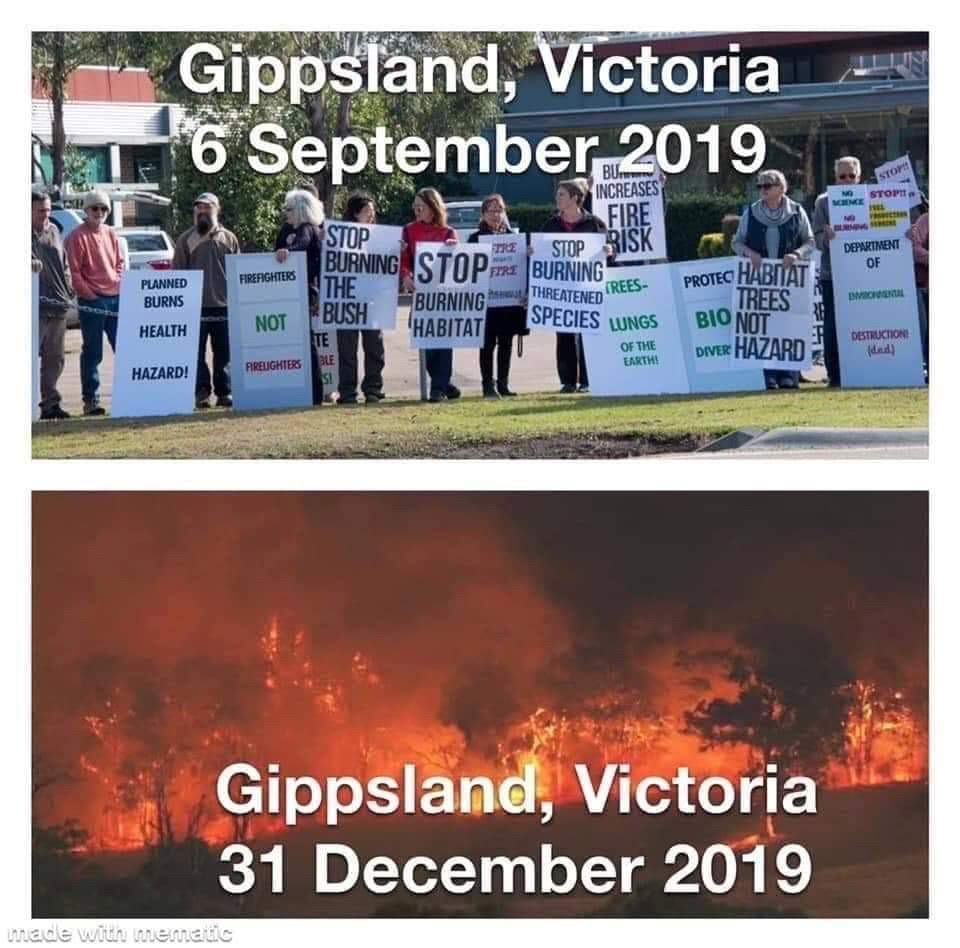
Back Go to page: 1 2 3 4 5 6 7 8 9 10 11 12 13 14 15 16 17 18 19 20 Forward